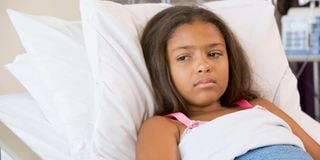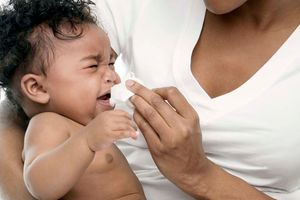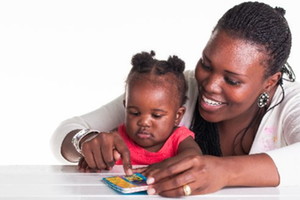Scoliosis: It is possible for your child to live a normal life

Persons with scoliosis are more likely to have children with the same problem.
What you need to know:
- The spine or backbone of a child with scoliosis has normal curves when looked at from the side and appears straight when looked at from the front.
- The most prevalent cause of scoliosis is hereditary.
- Congenital Scoliosis is usually present at birth if the spine was poorly formed in the womb or if the C shape is present. It is more severe and needs aggressive treatment.
When she was born, Baby Gladys was the picture of good health. “She was full of joy and good health. She seemed eager to grow, and looked taller each day,” says her mother Silvia Wambau. However, at the age of two, Silvia began to notice something strange with the girl’s physical development. “Her spine was not developing normally. But I thought it wasn’t a big deal because each child develops differently.” Towards the age of three, her disability became more noticeable. “Her head was not centred directly above the pelvis and she was developing a hump on the back,” says Silvia.
By the time Silvia consulted her pediatrician, her daughter’s condition had worsened. “Her left hip appeared higher than the right, and the skin overlying her backbone had changed both in colour and texture.” Silvia feared her daughter’s spinal deformity might affect her mental health.
“After a thorough screening, my pediatrician recommended we see an orthopedist,” says Silvia.
After a physical examination and a series of scans, Baby Gladys was diagnosed with Scoliosis, a physical disorder that causes an abnormal curve on the spinal cord. Scoliosis has been labeled a girls’ disease because it affects twice as many girls as boys.
According to Dr. Simon King’ori, an orthopedist, the spine or backbone of a child with scoliosis has normal curves when looked at from the side and appears straight when looked at from the front. “However, the child develops additional curves on either side.” The bones of the spine twist on each other, forming a C or an S shape in the spine. These shapes either lead towards the left or the right or are clearly seen when the spine or backbone of the child is viewed from behind.
Causes, Symptoms, and Diagnosis
The most prevalent cause of scoliosis is hereditary. “Persons with scoliosis are more likely to have children with the same problem,” says King’ori. But the extent in severity between the parent and the child will often vary.
But as Silvia attests, the cause does not always have to be hereditary. “The doctor enquired if there was anyone in our family with the same problem,” she says. “It was alarming since she had not suffered from polio either.”
Dr. King’ori says that there are four types of scoliosis.
Congenital Scoliosis: Usually present at birth if the spine was poorly formed in the womb or if the C shape is present. It is more severe and needs aggressive treatment.
Neuromuscular Scoliosis: Results from illnesses like cerebral palsy and polio, which damage the nerves and muscles that support the spine or backbone. This kind of scoliosis may become worse as the child grows.
Traumatic Scoliosis: It is caused by a spinal injury. “It corresponds with the age when the disease develops in the child,” observes King’ori. “If the child is under 3 years, the condition is known as infantile idiopathic scoliosis. If the child is between 3-10 years old, then it’s known as juvenile idiopathic scoliosis.”
Children with idiopathic scoliosis usually have normal spines for the first few years. However, their spines begin to curve before teenage. “My daughter’s spine was alright throughout her infant years. So it was puzzling when suddenly, her spine developed a hump,” says Margaret Nyakundi, whose daughter was diagnosed with scoliosis at the age of twelve.
Diagnosing scoliosis at home
“It would have been possible for Margaret and Silvia to tell whether their children were under the threat of a scoliosis attack, and the type they were likely to suffer from,” he says in regard to the two cases. How so?
“Ask your child to stand upright if she is able to or if she is of age. If she can’t stand on her own, then gently lay her on a flat surface,” he says. From her upright–standing or flat-lying position, carefully check if her spine is abnormally shaped or whether it appears to have an S or a C shape. If there are any noticeable curves or humps, consider seeing an orthopedist. “If you are not able to locate a specialist, consult with your child’s pediatrician, and they will direct you to one.”
Treatment
Usually, there are three types of treatment for scoliosis: Surgery, Observation, and Orthopedic Bracing.
Observation: According to Dr. King’ori, this kind of treatment is administered to children with Infantile Idiopathic Scoliosis. “It involves a series of X–Rays and daily observation to determine the extent of the deformity.” The observation phase also helps to see if the spine can recuperate back to its normal state.
Orthopedic Bracing: Here, your child is given a brace jacket which she wears throughout the prescribed treatment period. “The brace jacket supports the spine or backbone vertically, stopping the curve from getting worse while helping the spine to straighten.” The jacket is molded with foam on the inside and has straps on the outside. In most cases, this kind of treatment is recommended for children above the age of five.
Surgery: This form of treatment is performed on children with large curves on their spines or backbones. It is also recommended for children who have failed to respond to orthopedic bracing. “In this treatment, medical screws and metal rods are attached on each side of the spine,” says Dr. King’ori. “This effectively stops the curve from developing further.” However, the rods are not removed even after the bones have fused back together or the curve has stopped. “This is to prevent future relapses.” In most cases, full recovery following an orthopedic surgery reconstruction should take about six months, after which your child can lead a normal life again.





